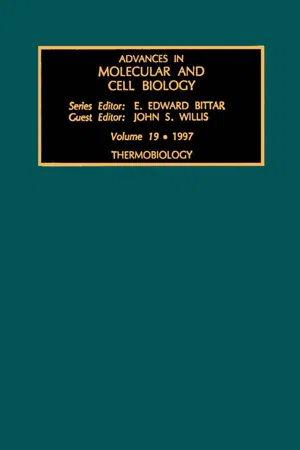Thermobiology
About this book
Notwithstanding widespread studies and even several biological journals devoted to temperature, it is difficult to perceive a field of thermobiology as such. Interest in the effects of temperature of biological systems is fragmented into specific thermal ranges and often connected with particular applications: subzero cryobiology and preservation of cells and tissues or survival of poikilotherms, para-zero cryobiology and preservation of whole organs and survival of whole animals, intermediate ranges and physiological adaption and regulation, high temperatures and use of heat for killing cancer cells, very high temperatures and limits of biological structure. Yet it has not always been so, and there are good reasons why it need not remain so. General and comparative physiologists such as W.J. Crozier, H. Precht, J. Belehradek, F. Johnson, C.L. Prosser, and others have sought throughout this century to lay foundations for unified approaches to temperature in biological systems.Recent findings also serve to suggest principles and processes that span the range of temperatures of biological interest. Microviscosity of membranes is an issue originally of interest to low temperature biologists but with relevance to limiting high temperatures; conversely for protein structure. Certain "heat shock proteins" now appear to be responses to generalized stress, including low temperature.Inevitably, the chapters of this book reflect the "zonal" character of thermobiology: two chapters (by Storey and Raymond) deal with protection against subfreezing temperatures; three (Hazel, membrane structure, Dietrich, microtubular structure, and Kruuv, cell growth) deal with the effects of and modulation to cool-to-moderate superfreezing temperatures, one (Willis) with modulation (of membrane ion transport) to moderate-to-high temperatures and two (Li, heat shock proteins and Lepock, proteins in general) with stressfully high temperatures. Explicit in each of these chapters, however, are principles and issues that transcend the parochialism of the temperature range under consideration.
Frequently asked questions
- Essential is ideal for learners and professionals who enjoy exploring a wide range of subjects. Access the Essential Library with 800,000+ trusted titles and best-sellers across business, personal growth, and the humanities. Includes unlimited reading time and Standard Read Aloud voice.
- Complete: Perfect for advanced learners and researchers needing full, unrestricted access. Unlock 1.4M+ books across hundreds of subjects, including academic and specialized titles. The Complete Plan also includes advanced features like Premium Read Aloud and Research Assistant.
Please note we cannot support devices running on iOS 13 and Android 7 or earlier. Learn more about using the app.
Information
Table of contents
- Front Cover
- Advances in Molecular and Cell Biology, Volume 19
- Copyright Page
- Contents
- List of Contributors
- Preface
- Chapter 1. Adaptations for Freezing Survival in Ectothermic Vertebrates
- Chapter 2. Responses of Marine Fishes to Freezing Temperatures: A New Look at Colligative Mechanisms
- Chapter 3. Thermal Adaptation in Biological Membranes: Beyond Homeoviscous Adaptation
- Chapter 4. Cold Adaptation of Microtubule Assembly in Antarctic Fishes
- Chapter 5. Survival of Mammalian Cells Exposed to Pure Hypothermia in Culture
- Chapter 6. On Thermal Stability of Cation Gradients in Mammalian Cells
- Chapter 7. Protein Denaturation During Heat Shock
- Chapter 8. The Role of Heat Shock Proteins in Thermotolerance
- Index
